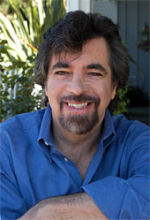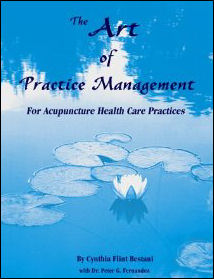Acupuncture & TCM Articles

Neil R. Gumenick is the founder and Director of The Institute of Classical Five-Element Acupuncture. Neil is a Worsley certified advanced teacher of Classical Five-Element Acupuncture and a practitioner with over 27 years of private practice experience. Neil holds three degrees from the College of Traditional Acupuncture (U.K.), and he participated for 10 years in the Master Apprentice Programô, led by Profs. J.R. & J.B. Worsley. Neil has taught at the USC and UCLA Schools of Medicine, the Worsley Institute of Classical Acupuncture, the Traditional Acupuncture Foundation, California Acupuncture College, Santa Barbara College of Oriental Medicine, and Pacific College of Oriental Medicine. He has been a Professor at Emperor's College of Traditional Oriental Medicine and SAMRA University of Oriental Medicine. Neil is co-author of The Art of Practice Management for Acupuncture Health Care Practices
The Initial Consultation: Getting to the Heart of the Matter, Part 7
By Neil Gumenick, MAc (UK), LAc, Dipl. Ac
In previous articles in this series, I discussed a number of areas of inquiry and exploration to help us determine who our patient is and what they truly need. In many ways, the Twelve Officials (organs/functions) speak to us and tell quite plainly what the needs of the patient are.
We perceive what is needed not only by the spoken word, but the way the words are spoken, with clues from the patient's sound, emotion, facial expression, body language, breathing, and physical contact with the patient.

In this article, I will discuss how to question a patient to obtain an early personal history. This includes such areas as where they were born and raised, the family and emotional environment in the home, school, interests and significant relationships. Some patients do not see any connection between their presenting complaints and their history and may question why we need to know this. To such patients, I point out that much of our present state of being may be rooted in past incidents: accumulated stresses that may have begun in childhood, ingrained patterns of behavior, lifestyle habits, as well as the influence of early primary relationships, such as with parents, siblings and significant others.
As with other areas of inquiry, one's past is rarely a neutral subject. It can provide a wealth of useful diagnostic information, as the Officials will reveal how they are imbalanced and traumatized, and what they need to recover. I often start with the question, "Where are you from, originally?" I note how the patient answers. The fact of a patient being from one place or another is of secondary significance compared to the emotional content of the answer and the accompanying sound of the voice. Thus, in order to delve deeper, I might ask, "How did you like growing up there?" This opens the door for the patient to express any likes and dislikes regarding early childhood. Some patients will willingly talk nonstop at this point. Others may need prompting. I let the patient's answer prompt my curiosity and lead me to the next question.
To encourage and guide a patient to express more, I might use such questions as, "Tell me who was present in your childhood home." I might hear about the mother and father, or a separation or divorce and its impact on the patient, the siblings, etc. I find it fascinating to see whom the patient talks about first and why. I might prompt with additional queries like: "What was the emotional environment like in your house," "Are your parents living," "Do you see or talk with them now," Were you close with your siblings growing up?" "What is your relationship with them now," "How did you do in school," "What did you most enjoy in school," or "Did you have a lot of friends or were you more of a loner?" Any of these questions can reveal not only the patient's Causative Factor (the primary element in imbalance), but also the patient's need at the level of the mind and spirit - even directing us to the choice of points.
Regardless of whether it is the main complaint, a secondary complaint or deeper issues that are revealed on further questioning, all patients have hopes and expectations of cure. Many will ask directly, "How many treatments will it take?" I do not make promises of cure. JR Worsley reminded us, "No man or woman can cure anything. Only nature can cure. All we can do is to help nature." It is unfair and unethical to fuel the patient's expectations of future results. Further, we cannot know how many treatments it will take, since all patients are unique. Factors such as how long a problem has existed, whether it is inherited or acquired, how deeply seated it is, the patient's overall energetic state, what environmental or lifestyle factors cause or aggravate the condition(s) all affect how long a patient will be in treatment or how many treatments will be required.
We can certainly explain the treatment interval we are recommending and express our hope to extend the interval as soon as it is appropriate. In my practice, I typically see new patients once a week for the first four to five treatments. If the patient is improving and the positive changes are holding from these first treatments at one week interval, I will move the patient to 10 days, then progress to two, three and four weeks, then longer, as I see fit. I recommend that even healthy patients come for a checkup at the change of the season. I explain that nature makes a shift at the change of season and we, who are part of nature, must also make that shift. Sometimes, seemingly healthy people will get sick at the change of season. Most of us have heard from patients, "I get this every year at this time." A seasonal tune-up keeps patients in better balance through the cycles of change, thus helping healthy people stay healthy. This process is open-ended.
I do not recommend relinquishing responsibility and letting the patient dictate the treatment interval. Patients must fully trust us with their care; to know not only what points to treat, but how often. Gaining this level of trust is our responsibility, and is accomplished through the rapport that we create with the patient. The only promise we can make is to do our best and to do everything in our power to help.
A male patient, age 41, when asked about his personal history, told me that he had always had difficulty relating to other people, beginning with his parents. He said that he couldn't remember not being afraid of people, though he didn't show it. Instead, he coped by withdrawing or becoming a "motormouth." In either extreme, he was unable genuinely to connect with anyone. In school, he was unable to form friendships or romantic connections, wondering, "Is this person right for me?" In the work world, he was unable to hold a job, utterly confused about what his real work was, often flitting from one job to the next. He acknowledged having poor social boundaries and inappropriately intruding into people's conversations or withdrawing into solitude.
What was most discordant about this account was the sound of the voice and the predominant emotion. Essentially describing a sad situation of confusion and isolation, the patient's voice sounded as if he were entertaining at a cocktail party. The patient laughed as he related the above and manifested the emotion of excess and inappropriate joy. Thus, I was presented with two "legs" of the diagnostic stool. Added to this, his lack of red color (also known as ashen grey), and the presence of a scorched odor, confirmed Fire as the Causative Factor element.
This patient's major challenge was in the function of the Small Intestine Official, whose job it is to separate the pure from the impure. As the brother to the Supreme Controller (Heart), this Official's job is to make sure that what is presented to the King is pure and unpolluted, allowing the King to rule in a fair, orderly and loving way, clearly seeing what is, without confusion. This patient lived in an internal state of disorder and lack of control. If the Small Intestine is failing in its function, what should be a free flow of give and take in relationships becomes blocked and polluted. This patient could not sort out his own needs or those of others, which resulted in inner confusion as to what was appropriate to say and what violated the boundaries of others. He could not see who was friend or foe, or whether the job at hand was good for him or not. He was easily distracted, disjointed in recounting his own experience and tended to see the outside world through a veil of conflicting negative perceptions. He could not extract the good from any situation.
Among the points I incorporated into the first treatments were the following, which I describe in order to show how we can use points, chosen for their spiritual connotation, to respond to the deepest needs the patient:
Small Intestine 7 Upright Branch: We cannot separate properly if we are not upright and straight. Straightness means not leaning, bending, compromising or being inconsistent. Straightness aligns us with what is true. When we see with the eyes of spirit, we can see and extract the goodness from even toxic situations and eliminate the waste. There is no confusion. We become internally aligned, even as our "branches" reach out to the world, or embrace and receive what the world has to offer. With uprightness comes the integrity to trust what we know to be the good.
Small Intestine 11 Heavenly Ancestor: The Chinese had great reverence for their ancestors - those who had gone before and held the vast wisdom of experience. Whether we take the concept of "ancestors" literally as elder beings on another plane of existence or figuratively, referring to a deep reservoir of wisdom within us, we all have access to the clarity that a "heavenly" perspective can provide. When the right answers seem to evade us and we don't know where to turn, this point brings the understanding, love and compassion of the "ancestors" to make clear what was confused and smooth what was chaotic. It is one of the most powerful points on the meridian for clearing the toxicity of the mind and spirit, and bringing peace and unity within and without.
 
The Art of Practice Management for Acupuncture Health Care Practices
What you will find in this book is a specific, comprehensive approach that gets to the root cause of success in practice.
This new book presents acupuncture practice as art from the standpoint of centering, qi, and wholeness. It builds on the premise that practices succeed from bridging inner and outer aspects of the self. It is an inquiry into the self and addresses clear understandings and approaches to reputable patient care and practice qi. It brings in the five elements and work with the seasons of practice from training and start-up to growth, stability, expansion and transformation. The authors artfully bridges the essence of both patient and practitioner well-being without excluding the practicalities of financial well-being. This book very specifically and extensively shows how the different parts of practice nourish and feed one another and are interdependent on one another for the qi to flow synchronistically.
It explores the dual nature of procedures that work and those which do not in acupuncture health care practice, returning again and again to the delicate balance of practicality and spirituality.
|
